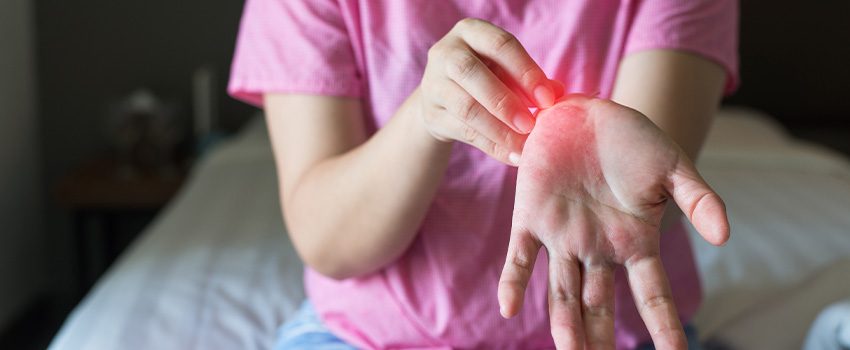Even if your detergent may smell like morning dew or spring rain, chances are that it’s packed with chemicals that can be harmful to your skin and health. It is not surprising to know that some people experience adverse skin reactions to these irritating ingredients. A laundry detergent allergy may develop during initial exposure or after repeated use.
What Causes Laundry Detergent Allergy?
Laundry detergents have surfactants or surface-eating agents to help remove dirt and oil particles on your fabrics. These ingredients, although helpful in the cleaning process, are injurious to the human skin.
Also, as mentioned above, there are artificial fragrances in our detergents that are common irritants too. Companies that make laundry detergents often use proprietary blends of scents, making it hard for customers to identify exactly what’s in them.
Other common allergens present in most laundry detergents include:
- Parabens
- Dyes
- Enzymes
- Emulsifiers
- Moisturizers
- Preservatives
- Softeners
- Solvents
- Thickeners
Laundry Detergent Allergy Symptoms
If your skin is sensitive to any of these ingredients, you’ll have signs and symptoms immediately after exposure. These include the following:
- Itchiness
- Red rash
- Blisters
- Bumps
- Swelling
- Tender skin
- Dry or cracking skin
Contact dermatitis may also occur because of a laundry detergent allergy. Your body comes into contact with washed clothing and linens, so signs and symptoms may appear just about anywhere. Some people find laundry detergent rash worse in areas where clothing gets wet with sweat, such as around the groin and armpits. A freshly washed pillowcase may also cause redness and itchiness to the sensitive skin on your face.
How Is It Treated?
If you are allergic to a specific chemical or irritant, you have to identify it and then take the steps to avoid it. Also, take note of the brand of detergent you had adverse reactions with.
Most rashes due to allergies can also be treated at home with simple remedies and lifestyle changes.
To ease your symptoms, you can do the following:
Apply a Steroid Cream
Look for an over-the-counter steroid cream that contains at least 1% of hydrocortisone. It will help relieve itching and inflammation.
Use an Anti-Itch Lotion
Are you familiar with Calamine lotion? It helps soothe the skin and prevent itching and scratching.
Take an Antihistamine
If the rashes have spread to different parts of your body, it is best to take an antihistamine to stop the reaction. Benadryl is a good brand.
Do an Oatmeal Bath
Have you ever tried doing an oatmeal bath? It’s cool and soothing! It will help reduce itching and skin swelling.
Wet Compress
Sometimes, all you need is a clean towel soaked in cool water to help soothe skin tenderness.
How Do You Prevent Laundry Detergent Allergy?
Use a Dye-Free or Fragrance-Free Detergent
Since artificial fragrances and dyes are the most common culprits of laundry detergent allergy, why not try other brands that use natural ingredients? Most allergy-free laundry detergents are vegetable-based, scent-free, and dye-free!
If you cannot find one, at least look for a soap that is mild for the skin.
Make Your Own Detergent
Did you know that you can formulate a homemade laundry detergent using borax and washing soda? This mixture is dye and scent-free. It’s cheap too! For extra cleaning power, you may add olive oil-based Castile soap.
Rinse Your Load Twice
An extra run through the rinse cycle may be helpful in preventing detergent residue from building up on your clothes, linens, and pillowcases.
Use Dryer Balls Instead of Fabric Softeners
To help reduce the number of chemicals being used on your clothes, skip fabric softener! You can still soften your clothes by using dryer balls, which are made from plastic, rubber, or wool. They can help reduce static without the use of irritants.
Try Baking Soda and Vinegar
Baking soda and vinegar make an excellent natural cleaning solution. Instead of detergent, use this solution on your second wash cycle. These non-irritating ingredients can help brighten and soften your clothes naturally.
Pre-Treat Stains
Chemical stain removers may also cause a laundry detergent allergy. Use a combination of baking soda, washing soda, and water to pre-treat stains in your clothes.
Clean Your Washing Machine
To make sure that there are no detergent residues in your washing machine, clean it after every load. A hot water cycle with vinegar and baking soda is effective in clearing soap scum and chemical buildup from the tub.
Wear Laundry Gloves
If you are hand washing your clothes, wear a piece of personal protective equipment like gloves to avoid direct contact with the chemicals in your detergent.
If you think you cannot do the laundry on your own due to your allergies, take your clothes to the best shop that offers general laundry services and dry cleaning in Durango, CO. We at Kelley’s Dry Cleaners care about you and your health. Call us now at 970-903-1642.



